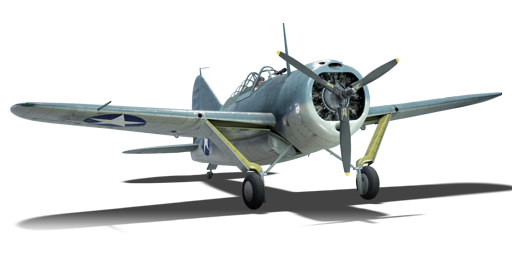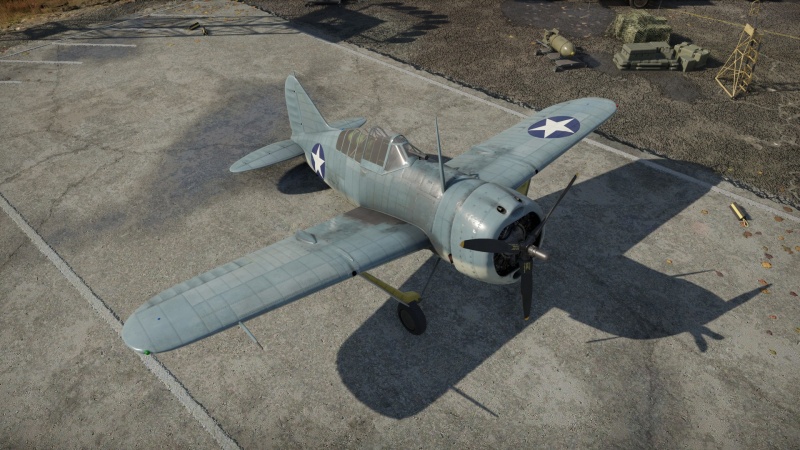Difference between revisions of "F2A-3"
U178117757 (talk | contribs) m (→Flight performance: AB and RB stock performance) (Tag: Visual edit) |
(→Flight performance) |
||
| (One intermediate revision by the same user not shown) | |||
| Line 33: | Line 33: | ||
|- | |- | ||
! Stock | ! Stock | ||
| − | | | + | | 495 || 476 || rowspan="2" | {{Specs|ceiling}} || 18.6 || 19.3 || 13.0 || 13.0 || rowspan="2" | 200 |
|- | |- | ||
! Upgraded | ! Upgraded | ||
Latest revision as of 08:12, 1 September 2024
| This page is about the American fighter F2A-3. For other versions, see F2A (Family). |
Contents
Description
The final version of the Brewster Buffalo was the F2A-3. Parts of the F2A-3's airframe were revised and the fuel capacity was increased to 908 L (240 gal). Although the fuel capacity was increased, the engine stayed the same which greatly diminished performance. The climb rate, top speed, and overall flight performance fell and pilots didn't enjoy flying it. The US Navy grew tired and annoyed at Brewster's constant issues with delivering aircraft on time and other problems. Squadrons using the F2A-3 quickly switched to the F4F Wildcat and were eventually sent to the Marine Corps. The F2A-3 saw its first major combat in the Battle of Midway where Buffalo pilots were hopelessly outmatched by A6M Zeroes. High-ranking officials within the US armed forces were greatly disappointed by the F2A-3's performance. Captain Phillip R. White would later say, "It is my belief that any commander who orders pilots out for combat in a F2A-3 should consider the pilot lost before leaving the ground." This marked the end of the Buffalo in active service and all Buffalos were relegated to training.
The F2A-3 Buffalo has been in the game since the start of the Open Beta Test prior to Update 1.27. The climb rate, top speed, and overall handling leave much to be desired. In the hands of a skilled pilot, however, it can account for itself very well due to excellent turning with judicious use of flaps and good handling characteristics. It also has no armour which leaves very critical components like the engine and fuel tanks vulnerable to enemy fire. However, the F2A-3 does come armed with four 12.7 mm machine guns, two firing through the propellor and two mounted in the wings, which is an improvement over the F2A-1's armament. It can also carry two 100 lb bombs which are mainly effective against open-topped vehicles, light tanks, and other soft ground targets.
General info
Flight performance
| Characteristics | Max Speed (km/h at 4,492 m) |
Max altitude (metres) |
Turn time (seconds) |
Rate of climb (metres/second) |
Take-off run (metres) | |||
|---|---|---|---|---|---|---|---|---|
| AB | RB | AB | RB | AB | RB | |||
| Stock | 495 | 476 | 18.6 | 19.3 | 13.0 | 13.0 | 200 | |
| Upgraded | 545 | 518 | 16.7 | 17.6 | 20.9 | 16.4 | ||
Details
| Features | ||||
|---|---|---|---|---|
| Combat flaps | Take-off flaps | Landing flaps | Air brakes | Arrestor gear |
| ✓ | ✓ | ✓ | X | ✓ |
| Limits | ||||||
|---|---|---|---|---|---|---|
| Wings (km/h) | Gear (km/h) | Flaps (km/h) | Max Static G | |||
| Combat | Take-off | Landing | + | - | ||
| 761 | 437 | 408 | 260 | ~12 | ~4 | |
| Optimal velocities (km/h) | |||
|---|---|---|---|
| Ailerons | Rudder | Elevators | Radiator |
| < 465 | < 400 | < 500 | > 310 |
Survivability and armour
- No armour
- Self-sealing fuel tanks (1 in each wing)
Modifications and economy
Armaments
Offensive armament
The F2A-3 is armed with:
- 2 x 12.7 mm M2 Browning machine guns, nose-mounted (250 rpg = 500 total)
- 2 x 12.7 mm M2 Browning machine guns, wing-mounted (400 rpg = 800 total)
Suspended armament
The F2A-3 can be outfitted with the following ordnance:
- Without load
- 2 x 100 lb AN-M30A1 bombs (200 lb total)
Usage in battles
The characteristics of the F2A-3 means that its pilots shouldn't try to turn-fight their opponents and that they should also strictly maintain their energy. However, its weight and energy retention ability mean that any Buffalo pilot that cares to climb high (3,000 - 4,000 m) will be able to combat opponents with relative ease. However, they should be wary of adept climbers (such as Bf 109s and the US' own P-47, at least in Arcade) as they are more than a match for the F2A's climb rate. In a dive, the Buffalo can rapidly catch up to virtually anything it faces, and, when it does, a battery of 4 x .50 cal (12.7 mm) machine guns will make short work of any target, save well-armoured bombers such as the B-25 or Ju 88, which an F2A pilot will probably rarely meet.
Discipline is a vital trait needed to master this plane. If you are used to simply engaging with the first opponent you find and turn-fighting, the F2A is not for you, as is much of the US fighter line. The recommended tactic to use with the F2A is Boom & Zoom. At the beginning of the battle, it is vital to climb - not climbing reduces your energy capabilities drastically due to the low level-flight speed of the F2A - climbing significantly improves performance of the F2A due to its weight and diving capabilities. After attempting a diving engagement on an enemy, whether successful or not, one should always pull out of the engagement shortly after the first attacking pass, so as not to waste speed and/or altitude (a.k.a. energy).
Four M2 Browning .50 MGs are plenty for a 2.7 BR plane - the heavy bullets rip through almost all fighters at this rank. Universal and Stealth rounds are the most effective belts - the Stealth being especially effective due to the M8 API bullets which allow F2A pilots to easily set opponents afire. Against bombers, the capabilities of the M2s are greatly reduced- aiming for engines is the most effective way to combat a bomber. You should always use the boom and zoom tactic as it works well for Japanese fighters at its rank. However, Japanese fighters will outturn you.
Manual Engine Control
| MEC elements | ||||||
|---|---|---|---|---|---|---|
| Mixer | Pitch | Radiator | Supercharger | Turbocharger | ||
| Oil | Water | Type | ||||
| Controllable | Controllable Not auto controlled |
Not controllable Not auto controlled |
Controllable Auto control available |
Separate | Controllable 2 gears |
Not controllable |
Pros and cons
Pros:
- Good dive speed and energy retention
- Highly manoeuvrable, very good in dog fights
- Great stealth armament
- Tail-hook for carrier landings
Cons:
- Poor acceleration
- Vulnerable fuel tanks (very prone to explosions)
- Poor level flight speed
- Engine overheats quickly. Loses lots of power due to minor damage or if left unchecked
- No armour to protect pilot; avoid any kind of head-ons or pursuit of heavy armoured planes with good defensive armament like the IL-2 or BV 238
History
The F2A-3 Buffalo was an interwar to early-WWII fighter aircraft of the United States Navy. Designed for the Navy's use on aircraft carriers, the F2A Buffalo was the first American monoplane naval fighter to enter service, beating the biplane XF4F design (which would later be redeveloped into the monoplane F4F Wildcat). The F2A served during the early days of WWII with the US navy, where it proved to be an ineffective fighter. The aircraft would be retired partway through the war with the development of more advanced aircraft.
In 1935, the Navy issued a requirement for a new monoplane fighter to replace the older F3F biplane naval aircraft. Several firms would design aircraft for the competition, including Brewster, who developed the XF2A Buffalo. Grumman submitted the XF4F, a traditional biplane fighter. After flight testing, the XF2A considerably outperformed the Grumman fighter, which wouldn't be produced in its biplane form, but would later reappear as the monoplane F4F Wildcat. Thus, the XF2A was ordered into production as the F2A Buffalo.
The F2A-3 was the last variant of the F2A to enter production, with 108 aircraft produced in total. The F2A-3 received additional fuel tanks and armour protection, but this made the aircraft significantly heavier and less agile. In American service, the F2A-3 Buffalo proved to be an ineffective aircraft, weaker than the highly-agile A6M Zero in most respects. They would be retired from active service with the introduction of newer, more advanced aircraft including the F6F Hellcat and F4U Corsair.
| Archive of the in-game description | |
|---|---|
|
The Brewster F2A Buffalo was the first monoplane carrier-based fighter that served in the American fleet. The aircraft had an all-metal construction, with the exception of the control surfaces, which were covered with cloth. In 1935, the U.S. Navy announced a competition to create a carrier-based fighter which was to replace the obsolete biplanes. The competition was won by the Brewster company and mass production of their F2A began in the summer of 1938. Of the 55 F2A-1s produced, only 11 entered service in the U.S. Finland, which was less demanding than other countries with regards to fighter specs, purchased the rest of the planes, which were then slightly altered for use on airfields. The F2A-2 variant had a more powerful engine and a pitched Curtiss Electric propeller. The subsequent F2A-3 had a stronger chassis and larger fuel tank. This last modification increased the aircraft's weight significantly, and the engine did not provide sufficient power, making the F2A-3 inferior even to the F2A-2 in handling and speed. The F2A was exported to a number of countries, including Finland and Great Britain. Of the 509 Buffaloes built, 107 were F2A-3s and 20 were B-439s (an export model of the F2A-3 transferred to the Dutch West Indies). | |
Media
- Skins
- Videos
See also
Links to the articles on the War Thunder Wiki that you think will be useful for the reader, for example:
- reference to the series of the aircraft;
- links to approximate analogues of other nations and research trees.
External links
| Brewster Aeronautical Corporation | |
|---|---|
| Fighters | F2A-1 · Thach's F2A-1 · F2A-3 |
| Export | ▄B-239 |
| USA fighters | |
|---|---|
| P-26 Peashooter | P-26A-33 · P-26A-34 · P-26A-34 M2 · P-26B-35 |
| P-36 Hawk | P-36A · Rasmussen's P-36A · P-36C · ○P-36C · P-36G |
| P-39 Airacobra | P-400 · P-39N-0 · P-39Q-5 |
| P-40 | P-40C · P-40E-1 · P-40E-1 TD · P-40F-10 |
| P-43 Lancer | P-43A-1 |
| P-47 Thunderbolt | P-47D-22-RE · P-47D-25 · P-47D-28 · P-47M-1-RE · ⋠P-47M-1-RE · P-47N-15 |
| P-51 Mustang | P-51 · P-51A (Thunder League) · P-51C-10 · P-51D-5 · P-51D-10 · P-51D-20-NA · P-51D-30 · P-51H-5-NA |
| P-63 Kingcobra | P-63A-5 · P-63A-10 · P-63C-5 · ␠Kingcobra |
| Prototypes | XP-55 |
| F2A Buffalo | F2A-1 · Thach's F2A-1 · F2A-3 |
| BF2C | BF2C-1 |
| F3F | F3F-2 · Galer's F3F-2 |
| F4F Wildcat | F4F-3 · F4F-4 |
| F4U Corsair | F4U-1A · F4U-1A (USMC) · F4U-1D · F4U-1C · F4U-4 · F4U-4B · F4U-4B VMF-214 · F2G-1 |
| F6F Hellcat | F6F-5 · F6F-5N |
| F8F Bearcat | F8F-1 · F8F-1B |
| Other countries | ▃Ki-43-II · ▃Ki-61-Ib · ▃A6M2 · ▃Bf 109 F-4 · ▃Fw 190 A-8 · ▃Spitfire LF Mk IXc |





